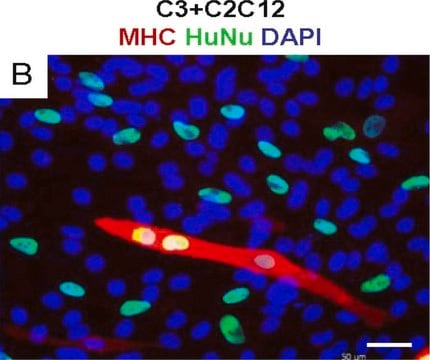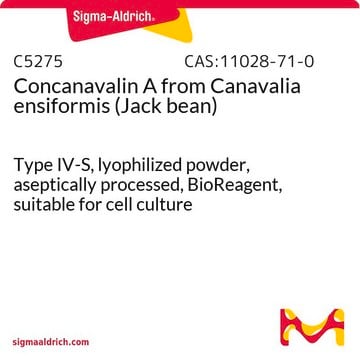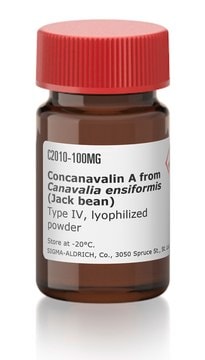MAB1281B
Anti-Human Nuclei Antibody, clone 235-1, Biotin Conjugate
clone 235-1, from mouse, biotin conjugate
Synonym(s):
HuNu
Sign Into View Organizational & Contract Pricing
All Photos(3)
About This Item
UNSPSC Code:
12352203
eCl@ss:
32160702
NACRES:
NA.41
Recommended Products
biological source
mouse
Quality Level
conjugate
biotin conjugate
antibody form
purified antibody
antibody product type
primary antibodies
clone
235-1, monoclonal
species reactivity
human
technique(s)
immunocytochemistry: suitable
isotype
IgG1
shipped in
wet ice
target post-translational modification
unmodified
General description
Cell replacement techniques such as stem-cell or fetal-cell therapies show great promise for many diseases. Cross-species grafting between human and animal cells or tissues requires the identification and localization of the donor material in the host environment. Antibodies to human-specific nuclei are useful cytological and histological markers for identifying human cells in xenograft models. MAB1281 stains nuclei of all human and primate cell types giving a diffuse nuclear staining pattern. Chromosomes are negatively stained in metaphase cells. The antibody does not react with nuclei from mouse or rat.
Specificity
This antibody recognizes human and primate nuclei. Antibody is not reactive with rat or mouse nuclei.
Immunogen
Human nuclei
Application
Detect Nuclei Marker using this mouse monoclonal antibody, Anti-Human Nuclei Antibody, clone 235-1 & Biotin Conjugate validated for use in ICC.
Evaluated by Immunocytochemistry in human bone marrow mesenchymal stem cells (SCR108). Immunocytochemistry Analysis: A 1:200 dilution of this antibody detected nuclei in human bone marrow mesenchymal stem cells (SCR108). Evaluated by Immunocytochemistry in primary mouse embryonic fibroblasts (PMEFs). Immunocytochemistry Analysis: A 1:200 dilution of this antibody did not detect nuclei in primary mouse embryonic fibroblasts (PMEFs).
Research Category
Stem Cell Research
Neuroscience
Stem Cell Research
Neuroscience
Research Sub Category
Neuroregenerative Medicine
Neural Stem Cell Migration
Neuroregenerative Medicine
Neural Stem Cell Migration
Quality
Evaluated by Immunocytochemistry in A431 human epidermoid cancer cells. Immunocytochemistry Analysis: A 1:200 dilution of this antibody detected nuclei in A431 human epidermoid cancer cells.
Physical form
Protein G Purified
Purified mouse monoclonal IgG1 conjugated to Biotin in PBS with 0.1% sodium azide and 15mg/ml BSA.
Storage and Stability
Maintain refrigerated at 2-8ºC protected from light in undiluted aliquots for up to 6 months from date of receipt.
Analysis Note
Control
A431 human epidermoid cancer cells.
A431 human epidermoid cancer cells.
Other Notes
Concentration: Please refer to the Certificate of Analysis for the lot-specific concentration.
Disclaimer
Unless otherwise stated in our catalog or other company documentation accompanying the product(s), our products are intended for research use only and are not to be used for any other purpose, which includes but is not limited to, unauthorized commercial uses, in vitro diagnostic uses, ex vivo or in vivo therapeutic uses or any type of consumption or application to humans or animals.
Not finding the right product?
Try our Product Selector Tool.
Storage Class Code
12 - Non Combustible Liquids
WGK
WGK 2
Flash Point(F)
Not applicable
Flash Point(C)
Not applicable
Certificates of Analysis (COA)
Search for Certificates of Analysis (COA) by entering the products Lot/Batch Number. Lot and Batch Numbers can be found on a product’s label following the words ‘Lot’ or ‘Batch’.
Already Own This Product?
Find documentation for the products that you have recently purchased in the Document Library.
Cesar A Garcia et al.
NPJ microgravity, 9(1), 92-92 (2023-12-19)
The emerging arena of space exploration has created opportunities to study cancer cell biology in the environments of microgravity and hypergravity. Studying cellular behavior in altered gravity conditions has allowed researchers to make observations of cell function that would otherwise
Ashwani Kumar Gupta et al.
Communications biology, 3(1), 231-231 (2020-05-13)
A fundamental challenge in emulating kidney tissue formation through directed differentiation of human pluripotent stem cells is that kidney development is iterative, and to reproduce the asynchronous mix of differentiation states found in the fetal kidney we combined cells differentiated
Tetsuro Tamaki et al.
Frontiers in physiology, 6, 165-165 (2015-06-18)
Skeletal muscle makes up 40-50% of body mass, and is thus considered to be a good adult stem cell source for autologous therapy. Although, several stem/progenitor cells have been fractionated from mouse skeletal muscle showing a high potential for therapeutic
Yohei Tsukada et al.
Scientific reports, 11(1), 745-745 (2021-01-14)
Angiogenesis contributes to numerous pathological conditions. Understanding the molecular mechanisms of angiogenesis will offer new therapeutic opportunities. Several experimental in vivo models that better represent the pathological conditions have been generated for this purpose in mice, but it is difficult
Kuang-Yui Chen et al.
Communications biology, 3(1), 363-363 (2020-07-11)
Histone H3.3 mutations are a hallmark of pediatric gliomas, but their core oncogenic mechanisms are not well-defined. To identify major effectors, we used CRISPR-Cas9 to introduce H3.3K27M and G34R mutations into previously H3.3-wildtype brain cells, while in parallel reverting the
Our team of scientists has experience in all areas of research including Life Science, Material Science, Chemical Synthesis, Chromatography, Analytical and many others.
Contact Technical Service






